
Charles William Read, known commonly as "Savez", was an officer in the antebellum United States Navy and then in the Confederate Navy during the American Civil War. He was nicknamed the "Seawolf of the Confederacy" for his exploits and daring.
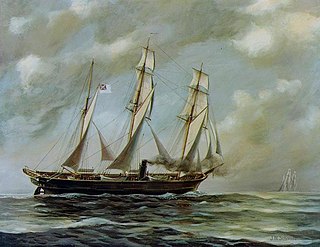
CSS Alabama was a screw sloop-of-war built in 1862 for the Confederate States Navy. The vessel was built in Birkenhead on the River Mersey opposite Liverpool, England, by John Laird Sons and Company. Launched as Enrica, she was fitted out as a cruiser and commissioned as CSS Alabama on August 24, 1862. Under Captain Raphael Semmes, Alabama served as a successful commerce raider, attacking, capturing, and burning Union merchant and naval ships in the North Atlantic, as well as intercepting American grain ships bound for Europe. The Alabama continued through the West Indies and further into the East Indies, destroying over seven ships before returning to Europe. On June 11, 1864, the Alabama arrived at Cherbourg, France, where she was overhauled. Shortly after, a Union sloop-of-war, USS Kearsarge, arrived; and on June 19, the Battle of Cherbourg commenced outside the port of Cherbourg, France, whereby the Kearsarge sank the Alabama in approximately one hour after the Alabama's opening shot.

CSS Manassas, formerly the steam icebreaker Enoch Train, was built in 1855 by James O. Curtis as a twin-screw towboat at Medford, Massachusetts. A New Orleans commission merchant, Captain John A. Stevenson, acquired her for use as a privateer after she was captured by another privateer CSS Ivy. Her fitting out as Manassas was completed at Algiers, Louisiana; her conversion to a ram of a radically modern design made her the first ironclad ship built for the Confederacy.

CSS Jamestown, originally a side-wheel, passenger steamer, was built at New York City in 1853, and seized at Richmond, Virginia in 1861 for the Virginia Navy during the early days of the American Civil War. She was commissioned by the Confederate States Navy (CSN) the following July, and renamed CSS Thomas Jefferson but was generally referred to as Jamestown, after Jamestown, Virginia.

CSS Shenandoah, formerly Sea King and later El Majidi, was an iron-framed, teak-planked, full-rigged sailing ship with auxiliary steam power chiefly known for her actions under Lieutenant Commander James Waddell as part of the Confederate States Navy during the American Civil War.

CSS Florida was a sloop-of-war in the service of the Confederate States Navy. She served as a commerce raider during the American Civil War before being sunk in 1864.
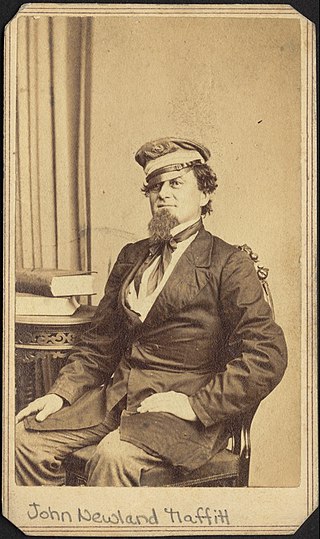
John Newland Maffitt was an officer in the Confederate States Navy who was nicknamed the "Prince of Privateers" due to his success as a blockade runner and commerce raider in the U.S. Civil War.

CSSEllis was a gunboat in the Confederate States Navy and the United States Navy during the American Civil War. It was lost during a raid while under command of famed Navy officer Lieutenant William B. Cushing.

CSSSelma was a steamship in the Confederate States Navy during the American Civil War. She served in the Confederate Navy first as Florida, and later as Selma. She was captured by the Union Navy steamer USS Metacomet during the Battle of Mobile Bay. She served as USS Selma until the end of the war, when she was decommissioned and sold for use as a merchant ship.

USS Mercedita was a wooden steamer that served as a gunboat in the Union Navy during the American Civil War.
CSS Clarence, also known as Coquette, was originally a brig from Baltimore captured by the Confederate cruiser CSS Florida during the American Civil War and converted into a Confederate cruiser for commerce raiding.
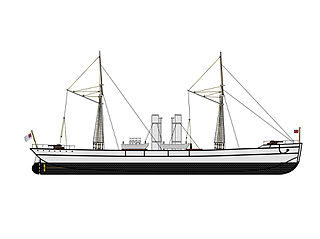
The CSS Tallahassee was a twin-screw steamer and cruiser in the Confederate States Navy, purchased in 1864, and used for commerce raiding off the Atlantic coast. She later operated under the names CSS Olustee and CSS Chameleon.

USS Aries was an 820-ton iron screw steamer built at Sunderland, England, during 1861–1862, intended for employment as a blockade runner during the American Civil War. She was captured by Union Navy forces during the Union blockade of the Confederate States of America, and was commissioned as a Union gunboat. Aries was named for the constellation.

USS Bermuda was a large steamer captured by the Union Navy during the American Civil War. She was used by the Union Navy as a cargo and general transport ship in support of the Union Navy blockade of Confederate waterways, primarily in Florida and the Gulf of Mexico. However, despite being a valuable cargo ship, she proved very adept at capturing blockade runners as her record proves.
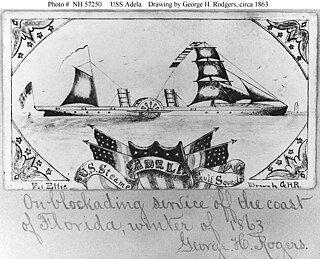
USS Adela was a steamer captured by the Union Navy during the American Civil War. She was used by the Union Navy as a gunboat in support of the Union Navy blockade of Confederate waterways.

USS Ascutney was a large steamer with powerful guns acquired by the Union Navy during the American Civil War. She was used by the Union Navy as a gunboat in support of the Union Navy blockade of Confederate waterways. Post-war, she performed some steamship service for the Navy.
The CSS Tuscaloosa was a ship captured by the Confederate States Navy during the American Civil War, and was initially known as the American bark Conrad. While en route from Buenos Aires to New York with a cargo of wool and goat skins, she was captured by the CSS Alabama on June 20, 1863, during the CSS Alabama's South Atlantic Expeditionary Raid. Fast and well-adapted for a cruiser, Capt. Raphael Semmes, CSN, commissioned her the next day as a cruiser and tender to the Alabama, renaming her Tuscaloosa. Two rifled brass 12-pounders and a plentiful supply of rifles, pistols, and ammunition were transferred to her with enough provisions for a 3-month cruise. Lt. J. Low, CSN, with 15 men, was ordered on board with instructions for an African cruise in the direction of the Cape of Good Hope.
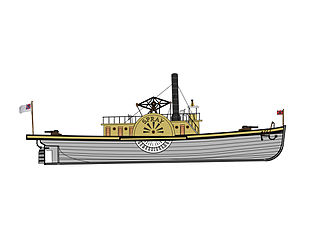
The CSS Spray was a steam-powered, side-paddle wheel tugboat built in New Albany, Indiana originally fitted as a mercantile ship before becoming a gunboat in the Confederate States Navy and used in the St. Marks, Newport, Florida area.
CSS Forrest was a wooden-hulled Confederate gunboat that saw action in the North Carolina sounds in 1861 to 1862. Despite being considered "worn out", she saw continuous service until destroyed after the battle of Elizabeth City in February 1862.

John Cummings Howell was an officer in the United States Navy during the American Civil War. He rose to the rank of rear admiral and late in his career was commander-in-chief of the North Atlantic Squadron and then of the European Squadron.
















